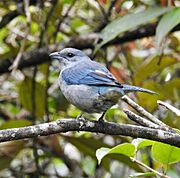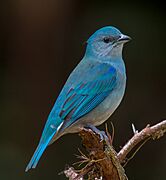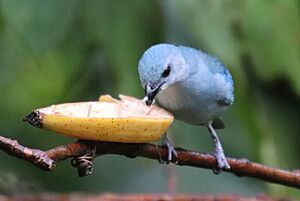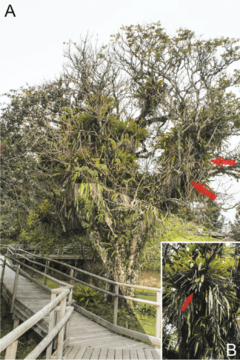Azure-shouldered tanager facts for kids
Quick facts for kids Azure-shouldered tanager |
|
|---|---|
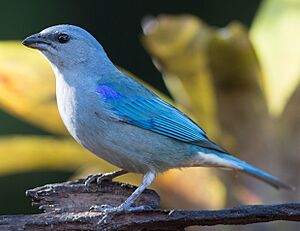 |
|
| Conservation status | |
| Scientific classification | |
| Genus: |
Thraupis
|
| Species: |
cyanoptera
|
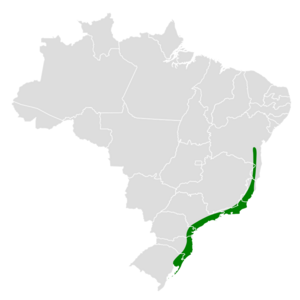 |
|
| Synonyms | |
|
|
The azure-shouldered tanager (Thraupis cyanoptera) is a beautiful bird. It belongs to the tanager family, called Thraupidae. This bird is special because it is only found in the Atlantic Forest of southeastern Brazil. You can spot it in places like Bahia, Minas Gerais, Espírito Santo, and Rio Grande do Sul.
These tanagers live in wet montane forests, open woodlands, and forest edges. They can be found high up in the mountains, sometimes as high as 1,600 m (5,200 ft). However, they usually stay below 1,200 m (3,900 ft). The azure-shouldered tanager eats fruits, flowers, and even leaves. Eating leaves is quite unusual for a bird! It often searches for food in groups of 15-20 birds.
Like other tanagers in Brazil, they start building nests after the dry season ends. Their nests are often hidden deep inside epiphytic bromeliads plants in trees. They usually lay two eggs. These eggs can be pale blue with dark purple spots or white with small brown spots. Sadly, this bird is considered near threatened. This is because its population is small, and its home is shrinking. Cities, factories, farms, and roads are taking away their forest habitat.
Contents
What is the Azure-Shouldered Tanager?
The azure-shouldered tanager was first described in 1817. A French zoologist named Louis Pierre Vieillot gave it the name Saltator cyanopterus. The name Thraupis comes from an old Greek word. It was used for a small bird mentioned by Aristotle. Today, it refers to tanagers. The word cyanopteros means 'dark-winged' or 'blue-winged' in Greek.
The official name for this bird is "azure-shouldered tanager". This name was given by the International Ornithologists' Union (IOU). In Brazil, people call it sanhaço-de-encontro-azul. The IOU and Clements Checklist place this bird in the Thraupis group. This group includes seven species found in the Americas.
What Does the Azure-Shouldered Tanager Look Like?
The azure-shouldered tanager is a large bird with a thick bill. It is about 18 cm (7.1 in) long. It weighs between 41–46 g (1.4–1.6 oz). Both male and female birds look very similar.
Adults are mostly bluish. Their upper parts and heads are gray-blue. The top of their heads is more bluish. Their throat and belly are lighter than their back. The tail and its feathers are bright blue. Their sides have a greenish tint. The feathers on their upper wings are a shiny violet-blue. The larger wing feathers are dark with wide turquoise-blue edges. The main flight feathers also have broad turquoise edges.
The top part of their beak is blackish. The bottom part is blue-gray. Their eyes are dark brown. Their legs are dark gray. Young birds are not as brightly colored as adults.
What Sounds Do They Make?
The song of the azure-shouldered tanager is unique. It starts with soft notes. Then it changes to clear, musical sounds. These sounds can be described as jittle-jittle-jittle, jeeeyr-jurr. They usually repeat these notes two or three times. You might also hear it as look heeere, right heeere, drink-drink-jrrr. The song becomes slower and more melodic as it goes on. Their calls include a thin sweee and other squeaky sounds.
Where Do Azure-Shouldered Tanagers Live?
This bird is only found in the Atlantic Forest of southeastern Brazil. You can find it from southeastern Bahia down to northern Rio Grande do Sul. Some reports said it was in Paraguay, but those were likely other birds.
It prefers living in forests more than other tanagers. It likes wet montane forests, open woodlands, and forest edges. On Santa Catarina Island, they have even been seen in fruit orchards. They are mostly found on the Atlantic slopes of Serra do Mar. These birds can live up to 1,600 m (5,200 ft) high. But they usually stay below 1,200 m (3,900 ft). They probably do not migrate, meaning they stay in the same area all year.
How Do Azure-Shouldered Tanagers Behave?
What Do Azure-Shouldered Tanagers Eat?
Azure-shouldered tanagers love fruit. They also eat flowers and leaves. They eat fruits from plants like Psychotria constricta and Eugenia umbelliflora. They also enjoy flowers and leaves from Acnistus arborescens and Solanum plants. Eating leaves is a very unusual part of their diet.
Like other tanagers, they chew fruit. They often leave parts of the fruit under the tree. Even though their mouths are small, they can crush bigger fruits. This allows them to eat fruits of many different sizes. One study found that these tanagers help spread seeds. They often drop seeds in good places for new plants to grow.
They usually look for food in groups. These groups can have 15 to 20 birds. Sometimes they are all azure-shouldered tanagers. Other times, they mix with different bird species. They often forage in tall trees. They can be quite aggressive towards other similar tanagers.
How Do Azure-Shouldered Tanagers Raise Their Young?
The breeding season for these tanagers starts after the dry season. This is similar to other tanagers in southeastern Brazil. Breeding has been seen in October in Espírito Santo. It has also been seen in September in Rio de Janeiro.
Both male and female birds help build the nest. They use long strips of dry leaves, often from bromeliad plants. Nests are usually built in tangles of epiphytic bromeliads in trees. These trees are usually 10 to 12 m (33 to 39 ft) tall. The nests are about 4.13–6 m (13.5–19.7 ft) above the ground. They are hidden deep inside the plants. This protects them from light and rain. These birds can even build nests in busy cities.
Their nests are shaped like shallow cups. They are lined with fine plant fibers and grass leaves. Sometimes, they even use black fungal threads. The exact materials can be a little different for each bird.
They usually lay two eggs at a time. Early descriptions said the eggs were pale blue with dark purple spots. More recent observations show them as white with small brown spots. This difference might be natural. Eggs are about 28.0–29.9 mm (1.10–1.18 in) long and 18.2–18.6 mm (0.72–0.73 in) wide. They weigh about 4.5 g (0.16 oz). Baby birds have pink skin and gray fuzz. Their beaks are yellow-brown.
Protecting the Azure-Shouldered Tanager
The International Union for Conservation of Nature (IUCN) lists the azure-shouldered tanager as near threatened. This means it could become endangered soon. Its population is small, and its habitat is disappearing. It lives in a specific area called the Atlantic Forest Lowlands. It is not very common there.
This bird prefers wet forests. It doesn't do as well in new forests or forest edges. This has caused its population to drop. In the past, its forest homes were cut down for farming, mining, and plantations. Now, cities, factories, farms, and roads are the main threats.
Sadly, azure-shouldered tanagers have been caught and sold illegally. This happens in street markets in Brazil. Their population is likely decreasing slowly. Luckily, these birds live in some protected areas. These include national parks and state parks. The Sooretama Biological Reserve also protects them.
To help these birds, we need to:
- Keep track of how many birds there are.
- Document how much habitat is being lost.
- Understand how much habitat disturbance they can handle.
- Protect their suitable forest homes.



